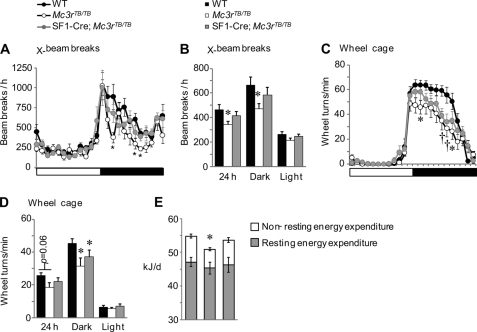FIGURE 5.
Impact of altered Mc3r expression on locomotor activity (A–D) and non-resting energy expenditure (E). A and B, assessment of locomotor activity using cross-beam breaks (X-beam breaks) in WT (n = 16), Mc3rTB/TB (n = 8), and SF1-Cre;Mc3rTB/TB mice (n = 8). A shows movement in bins of 1 h, with each point being the mean of 3 days of measurements, whereas B shows movement expressed as total 24-h activity, activity during the dark period, and activity during the lights-on period. Mc3rTB/TB mice exhibit periods of reduced activity during the dark period (*, p < 0.05 versus WT). This phenotype is attenuated in SF1-Cre;Mc3rTB/TB mice. C and D, wheel-running activity of WT (n = 12), Mc3rTB/TB (n = 14), and SF1-Cre;Mc3rTB/TB mice (n = 13). C, activity in 1-h bins; each bin was an average of 2 days of measurements (*, p < 0.05 WT versus Mc3rTB/TB; †, p < 0.05 WT versus Mc3rTB/TB,SF1-Cre;Mc3rTB/TB). D, analysis of the data expressed as total 24-h activity, activity during the dark period, and activity during the lights-on period. Mc3rTB/TB and SF1-Cre;Mc3rTB/TB mice are less active in the dark period when compared with WT controls (*, p < 0.05 versus WT). E, reduced non-resting energy expenditure observed in Mc3rTB/TB mice is not observed in SF1-Cre;Mc3rTB/TB mice (*, p < 0.05 versus WT); resting energy expenditure was not significantly affected by genotype.

